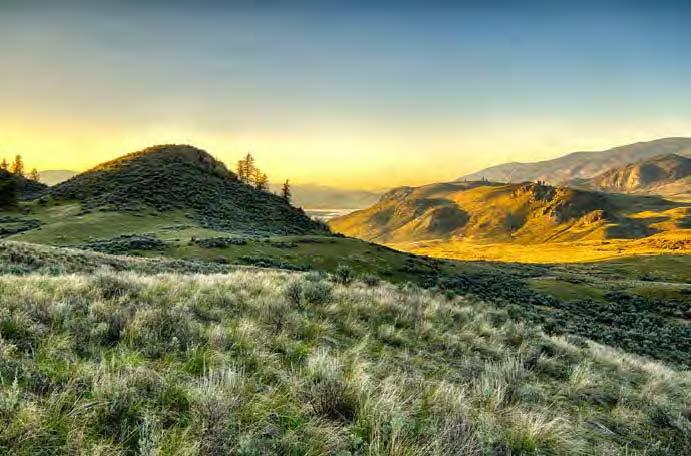
The Charles and Mary Eder Unit, an important wintering area for mule and white-tailed deer, is east of the town of Oroville and Osoyoos Lake. Through an agreement, the seller of this unit has withheld a life estate in the center of the property; more than 700 acres of agricultural fields, houses, and outbuildings are private and closed to public access. The unit is managed as a quality hunting area thereby limiting the number of hunters that can access the property during the respective deer seasons. Hiking, biking, and horseback riding are enjoyed here. Although non-motorized recreational activities are allowed, currently there are no developed trail systems.
The Charles and Mary Eder Unit is located 3 miles northeast of Oroville in Okanogan County. The unit can be accessed from Eder Road, off of the Eastlake Road, and off of Chesaw Road.
The Charles and Mary Eder Unit occurs along Nine-mile and Tonasket creeks which both drain into the Okanogan River in the Columbia River Basin. The Nine-mile Creek flows west toward Lake Osoyoos. The Okanogan National Forest is located further south. Private lands include a ranch-subdivision and fruit orchards.
This unit is part of the Scotch Creek Wildlife Area.
Game Management Unit: 204
Getting there
Maps and directions to WDFW-managed access points for this unit. Opens Google Maps in a new tab.
Recreation and public access
A Discover Pass is required on WDFW lands -- including water access areas, wildlife areas, and campgrounds -- unless you already have a Vehicle Access Pass issued with the purchase of an eligible hunting or fishing license. Recreate responsibly on public lands: please know the Public Conduct Rules.
Public facility information:
- Parking at entrance on Eder Road and along the Molson Chesaw Road
Recreation and access advisories
- Please respect private property — do not trespass. About 700 acres, in the center of this unit, is private property closed to public access, and the property boundary is marked through the sagebrush and shrubsteppe with tall PVC pipes.
- Only non-motorized recreational activities are allowed.
- This unit is closed to the general public during deer hunting season.
Hunting
Deer hunting is popular on this unit, but the area is managed for quality hunting, which limits the number of hunters during deer seasons. The area is open for public use at all other times of the year, and hunting for upland birds and small game are open per pamphlet regulations.
Hunting advisories
- The area is managed as a quality hunting area thereby limiting the number of hunters that can access the property during the respective deer seasons. Permits are drawn each August for modern firearm, archery, muzzleloader, late white-tailed deer, and youth permits. The area is open for public use at all other times of the year, and hunting for upland birds and small game are open per pamphlet regulations.
Wildlife viewing
This unit includes shrubsteppe, creeks, riparian habitat, offering opportunities to view a variety of wildlife, including mule and white-tailed deer, and raptors.
East of Osoyoos Lake, shrubsteppe habitats offer opportunities to view hundreds of migratory deer in winter.
Search for potential birding opportunities on or near a wildlife area unit by using eBird Northwest, a citizen science database portal that provides freely-shared bird lists at 'hotspots' and interactive maps plus other birding information updated daily.
Other recreational opportunities
This unit offers opportunities for hiking, biking, horseback riding, and nature photography.
The unit occurs along Nine-mile and Tonasket creeks, which both drain into the Okanogan River in the Columbia River Basin. Nine-mile Creek flows west toward Lake Osoyoos. The Okanogan National Forest is located further south. Private lands include a ranch subdivision and fruit orchards.
Conservation
The unit's lands are predominately shrubsteppe habitat, with riparian habitat along Nine-mile and Tonasket creeks. The shrubsteppe habitats east of Osoyoos Lake are critical wintering grounds for several hundred deer each winter.
Special habitats and species
The unit shares its northern boundary with Canada, and provides habitat connectivity for the protection of gray wolves, grizzly bear and lynx, and low elevations attract large numbers of migratory deer, raptors, and other wildlife.
Conservation goals
- Restore degraded shrubsteppe habitat
The unit shares its northern boundary with Canada, and provides habitat connectivity for the protection of gray wolves, grizzly bear and lynx, and low elevations attract large numbers of migratory deer, raptors, and other wildlife.
- Restore degraded shrubsteppe habitat
Land stewardship
The seller of this unit has withheld a life estate in the center of the property; approximately 700 acres of agricultural fields, houses and many outbuildings are private property and is off limits to hunting, fishing and trespassing. While the life estate is in force, no public use of this portion of the unit is available.
Acquisition history
The parcels making up this area were purchased between 2007 and 2022.
| Funder | Fund |
|---|---|
| Bonneville Power Administration | Mitigation Funds |
| US Fish and Wildlife Service | Endangered Species Act Section 6 Program |
| WA Recreation and Conservation Office | Washington Wildlife and Recreation Program |
Management planning
2017 Scotch Creek and Sinlahekin Wildlife Areas Management Plan
In 2017, the Washington Department of Fish and Wildlife updated the management plan for the Scotch Creek Wildlife Area, which encompasses 23, 980 acres in Okanogan County, and the nearby Sinlahekin Wildlife Area in north central Washington. The plan, called the Scotch Creek & Sinlahekin Wildlife Area Management Plan, addresses the status of wildlife species and their habitat, ongoing restoration efforts and public recreation opportunities at both Scotch Creek and Sinlahekin wildlife areas. Every eight to 10 years, WDFW revises management plans for each of its 33 wildlife areas to document current conditions, address new agency initiatives, and identify new management priorities and actions. In between those major revisions, WDFW updates plans every two years to outline short-term objectives and accomplishments.
Planning Advisory Committee
Okanogan Valley Wildlife Area Advisory Committee